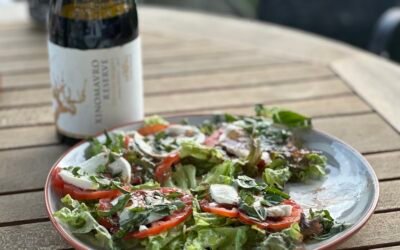
Dish of gluten-free Ahi Tuna Niçoise. Photo courtesy of The Grill at Silverado Resort via Napa Valley Life Magazine.
Ten years ago, when celebrities started touting that by eliminating gluten, they lost weight, cured insomnia, and improved their thinking, it became a fad, and people began to follow a gluten-free diet without even understanding what it was or its effects on the human body. Today, there is greater awareness of the impact of gluten on gut health and its involvement in celiac disease, which has led to increased understanding and adaptation by the food and restaurant industry to make following a gluten-free lifestyle easier and delicious.
The Science of Gluten and Related Health Conditions
Gluten is found in the endosperm of grains and is a mixture of hundreds of proteins. Still, the two primary proteins are gliadin, which helps with rising, and glutenin, which provides elasticity. Gluten holds a baked product together and gives it that chewy texture, making bread enjoyable to eat. Foods containing gluten include bread, baked goods, pasta, snacks, and beer made from wheat, rye, and barley. It is also found in food additives, condiments, and sauces such as modified wheat starch, soy sauce, and teriyaki marinade. The grains bulgar, farro, and couscous, commonly found on menus, also contain gluten.
The decision to not consume gluten is not an option for people diagnosed with celiac disease (CD), as gluten must be avoided to maintain gut health and overall wellness. CD is an autoimmune disease that damages the small intestine and interferes with nutrient absorption. Experts at the National Institute of Diabetes and Digestive and Kidney Diseases estimate that 1 in 133 people in the United States have celiac disease. That is 1% of the total population, or 2 million people. However, over 80% of people with celiac disease are undiagnosed or misdiagnosed.
Symptoms of CD can include bloating, cramping, diarrhea, weight loss, chronic fatigue, anemia, and reproductive issues. The onset of CD can occur within weeks or after years of gluten exposure and can happen at any age.
For many years, scientists and physicians did not feel there was evidence of any benefit to following a gluten-free diet for people not diagnosed with CD. However, in 2015, an expert panel of researchers agreed that some individuals suffer from what they named non-celiac gluten sensitivity (NCGS). Unlike celiac, NCGS causes a non-specific immune response clinically recognized as less severe than CD and without intestinal mucosal damage and permeability. NCGS has similar intestinal symptoms to CD, as well as headaches, muscle tingling/numbness, and “foggy brain,” the non-intestinal symptoms often prevail in those afflicted with NCGS.

Dish of Roasted King Salmon. Photo courtesy of Lucy Restaurant via Napa Valley Life Magazine.
Gluten-Free Foods
Whether one has celiac disease, non-celiac gluten sensitivity, or wants to avoid gluten for general health reasons, plenty of foods are available for a well-balanced and tasty diet.
Many foods are naturally gluten-free (GF), including fruits, vegetables, beans, nuts, legumes, dairy products, fresh meat, fish, and poultry. The GF diet includes grains such as quinoa, polenta, brown rice, buckwheat, sorghum, millet, and others. Oats can be part of the diet but are often milled with gluten-containing grains, so they must be certified GF. To maintain a healthy weight, avoid overconsuming packaged GF snacks and desserts, which can be high in fat and sugar. If possible, bake at home using certified gluten-free all-purpose flour. Consult the BeyondCeliac.org website for recipes and more information about GF baking.
Needing to follow a GF diet in the past often came with a decrease in dining-out options, and some people with celiac disease eliminated going out to eat altogether out of concern of gluten cross-contamination during food preparation and the possibility of getting sick. But today, with increased knowledge by restaurants and chefs of the GF diet, the options for GF diners have improved dramatically.
Restaurants use three approaches to provide customers with a GF dining experience. One is to create a separate GF menu listing all the items available, from appetizers to desserts; another is to place a GF symbol or the words “gluten-free” next to menu items that are or can be modified to be GF. The last approach is to ask customers if they have any dietary issues. To be sure a meal contains no gluten, it is best to respond that it is a gluten “allergy” even though technically, CD and NCGS are not food allergies.
Regardless of how a restaurant provides information about its GF options, it can still be a challenge for diners. It is essential to ask questions, perhaps even calling ahead, to learn how a dish is prepared or what modifications can be made. Certain types of cuisine naturally lend themselves to providing GF options. Italian, Mexican, Asian, and Mediterranean restaurants can provide an array of foods to choose from that are naturally GF.
Risotto, corn tortillas, sushi rolls, and rice dishes are among the choices. However, some menu items may sound GF but incorporate flour into their preparation. For example, béchamel sauce uses flour for thickening, in sole meunière, fish is dusted with flour before being sautéed, and chicken fricassee comes in a gravy thickened with flour.

Dish of Wagyu Filet. Photo courtesy of Eiko’s via Napa Valley Life Magazine.
Dining Out Safely, Gluten-Free
In his book “Gluten Freedom,” Dr. Alessio Fasano, director of the Center for Celiac Research at Massachusetts General Hospital, outlines in more detail how to dine out safely and enjoyably with celiac disease, gluten sensitivity, or a wheat allergy. Check the bottom of this article for a list of food preparation techniques from the book to avoid when eating out.
In Napa Valley, several restaurants offer delicious GF dining options. Brix Restaurant in Yountville provides a dedicated GF menu with items like Crispy Kohlrabi Fritters and Wood-Grilled Steak Frites. At Eiko’s Japanese restaurant in Napa, items on their extensive menu are labeled GF- gluten-free and GFM – gluten-free modified. Allison Hallum, Director of Operations at Eiko’s, said, “At Eiko’s, we try to use gluten-free options whenever possible, and we are usually able to accommodate allergies with reasonable substitutions. For example, our chef uses tamari in our Wagyu Filet Steak to create the brandy cream sauce, and he ensures there is no gluten in the spices or rubs.”
At the Silverado Resort, GF options are available at The Grill and Mansion Bar. Executive Chef Patrick Prager shared, “At Silverado Resort, we embrace all dietary preferences and keep our menus dynamic. We’re also pleased to customize existing menu items or create something special to delight our guests.” For those who love Italian fare, Il Posto Trattoria in Napa makes GF pasta in-house and can offer almost any pasta-based dish GF, according to owner Justin Graffigna.
He stated, “I like to have gluten-free options because I have always felt that everyone deserves to have a great meal. People cannot help it if they have celiac disease, and it is important for them to taste our food. We do the best we can to accommodate everyone”. Look below for examples of Napa Valley restaurants’ GF dishes.

Dish of House-Made Tater Tots. Photo courtesy of The Mansion at Silverado Resort via Napa Valley Life Magazine.
Gluten-Containing Menu Preparations to Avoid
- Au Gratin: Browned breadcrumbs and grated cheese
- Beurre Manie: Butter flour mixture to thicken sauces
- Dusted: lightly sprinkled with dry ingredients like flour
- Encrusted: Flour or breadcrumbs encasing a food item
- Farfel: A soup garnish made of minced noodle dough
- Fritter: Vegetable combined with eggs and flour and fried.
- Pan Gravy: Sauce made from meat juices and usually thickened with gravy.
- Roux: Butter and flour mixture used to thicken soups and sauces.
- Soy Sauce: Made from fermented soybeans and wheat.
- Tempura: Meat, seafood, or vegetables coated in flour-based batter and fried.
Sample of Gluten-Free Dishes at Napa Valley Restaurants
- Homemade Gluten-free Pasta | Il Posto Trattoria, Napa
Italian sausage, cauliflower, red cabbage, chiles, fontina cheese. - Ahi Tuna Niçoise | The Grill at Silverado Resort, Napa
Marble potatoes, haricot verts, quail egg, greens, olives, sherry vinaigrette. - House-Made Tater Tots | The Mansion Bar at Silverado Resort, Napa
Braised short rib, fontina, pickled pearl onions, bordelaise, thyme - Garlic Herb-Crusted Grilled Rack of Lamb | Eiko’s, Napa
Fondant potatoes, honey-glazed carrots, and a red wine reduction sauce. - Grilled Chicken Kebab* | Tarla Mediterranean Grill, Napa
Marinated with Mediterranean Spices, served with Roasted Vegetables and Chimichurri sauce. - Roasted King Salmon Fillet | Lucy Restaurant and Bar, Yountville
With sweet yellow corn, baby fennel, fingerling potatoes, and Cippolini onions.
*Note: As listed on the restaurant website.
This article was originally written for Napa Valley Life Magazine, and was published online on May 14, 2025. See the original article here: https://napavalleylife.com/dining-deliciously-gluten-free/. See all of Susan’s previously published articles here: https://alwayssharingwine.com/tag/previously-published.



